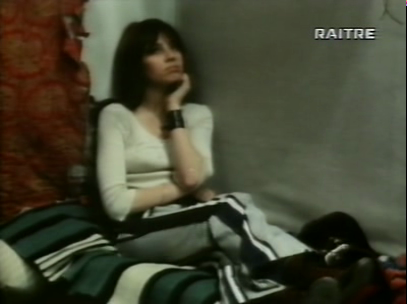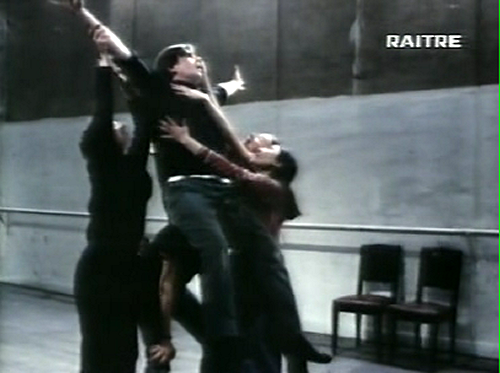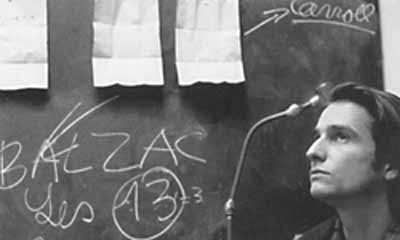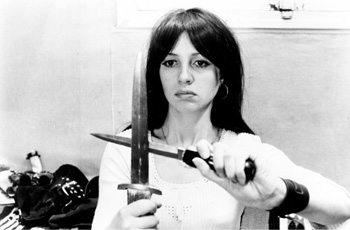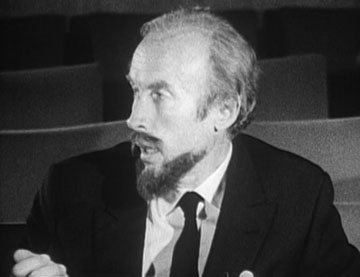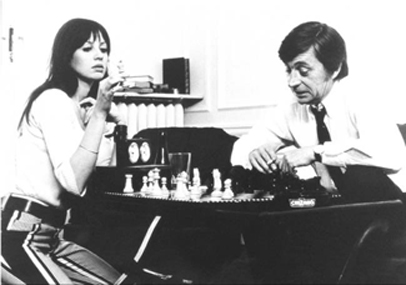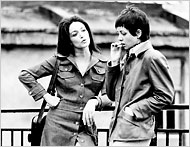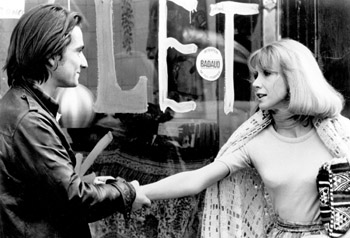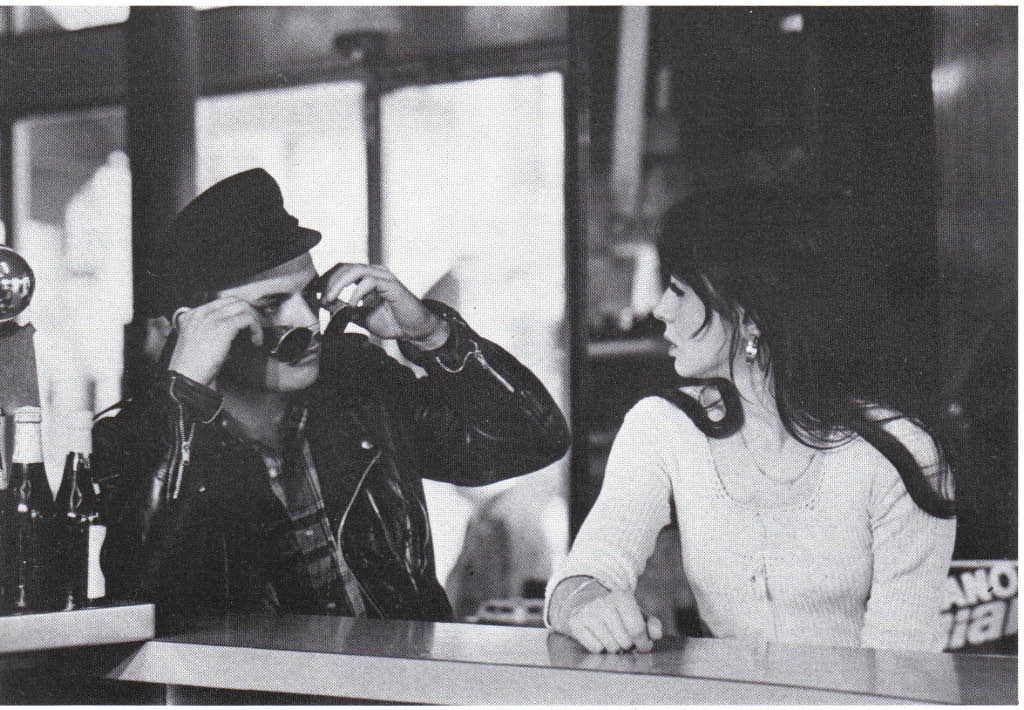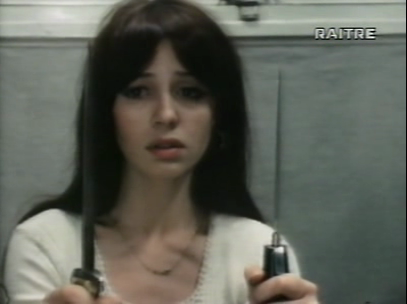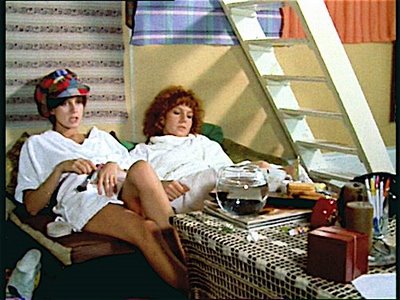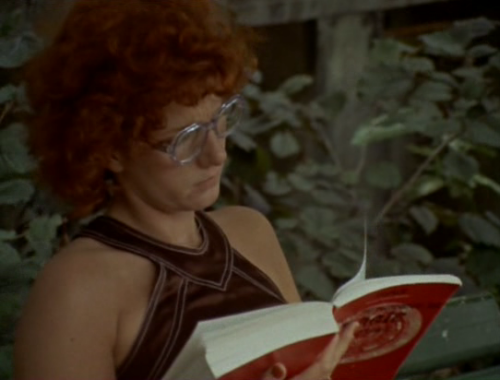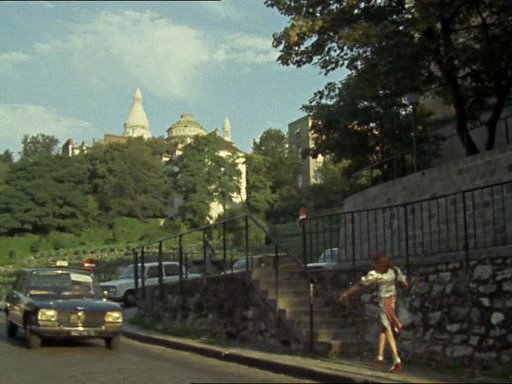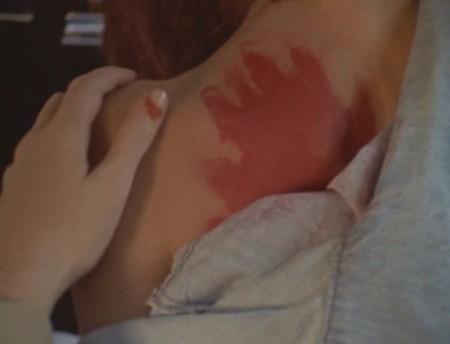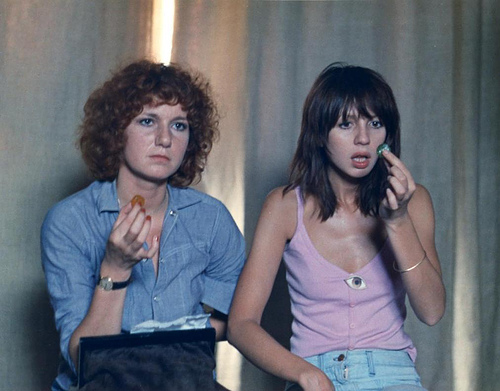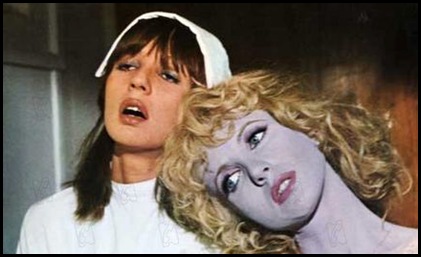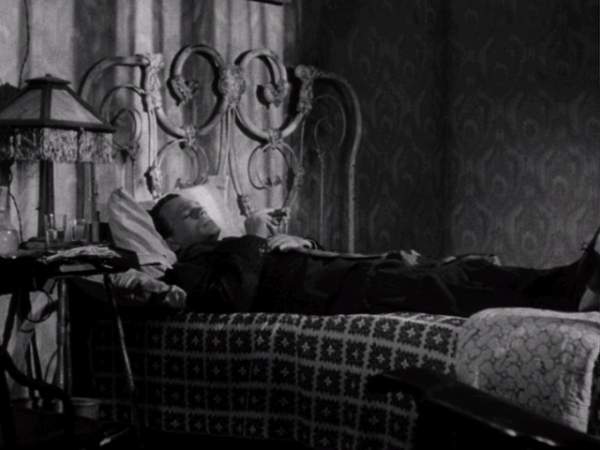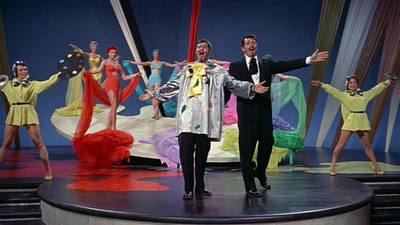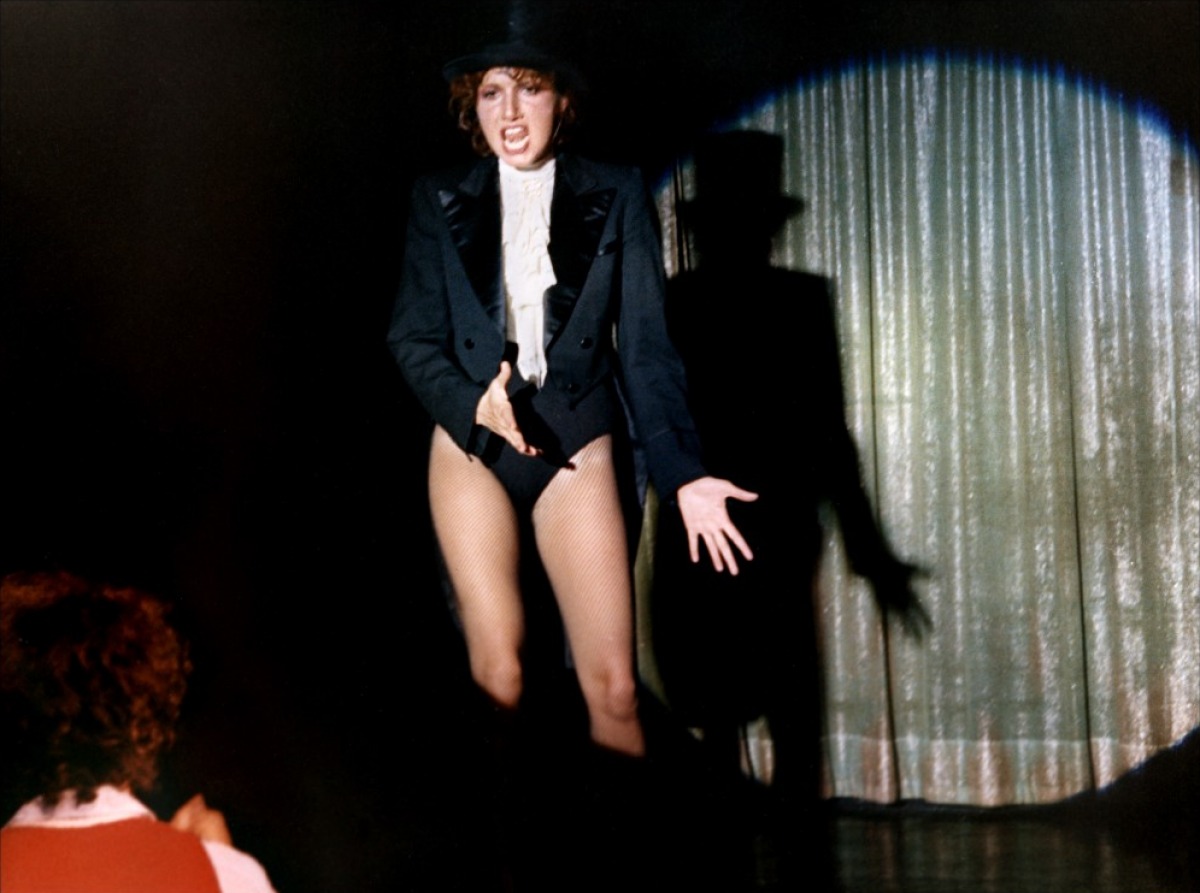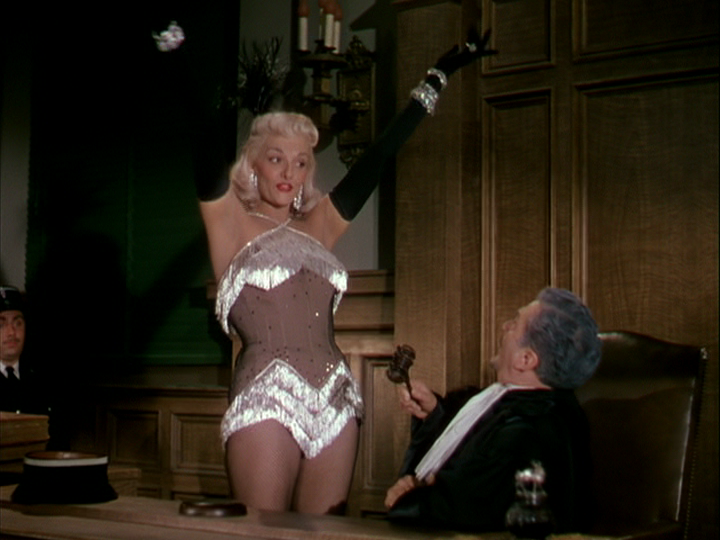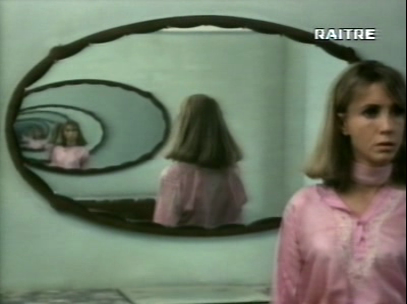From the Autumn 1974 Sight and Sound.
In the spring of 1970, Jacques Rivette shot about thirty hours of improvisation with over three dozen actors. Out of this massive and extremely open-ended material have emerged two films, both of which contrive to subvert the traditional movie going experience at its roots. Out 1, lasting twelve hours and forty minutes, has been screened publicly only once (at Le Havre, 9-10 September 1971) and remains for all practical purposes an invisible, legendary work. (Its subtitle, significantly, is Noli Me Tangere.) Spectre, which Rivette spent the better part of a year editing out of the first film — running 255 minutes, or roughly a third as long — was released in Paris earlier this year. And during the interval between the editing of Spectre and its release, Rivette shot and edited a third film, Céline et Julie vont en Bateau, 195 minutes in length, which surfaced in Cannes last May. The differences between and Spectre and Céline et Julie vont en Bateau are considerable: they are respectively the director’s “heaviest” film and his “lightest,” probably the least and most accessible of his six features to date. Both of them clearly situate Rivette in the forefront of narrative innovation in contemporary French cinema, exhibiting a sophistication about the entire fiction-making process that seems to go well beyond the recent efforts of his peers. On a narrative level, one might say that they resume a line of development abandoned by Resnais after Last Year at Marienbad and Muriel, and by Godard after 2 or 3 Things I Know About Her and Made in U.S.A.
To have fused many of the concerns of these separate lines of inquiry is remarkable enough. What is more remarkable still is that Rivette has extended them, into the outer reaches of a terrain that the following notes can only attempt to sketch.
1
[Ornette Coleman’s Free Jazz] causes earache the first time through, especially for those new to Coleman’s music. The second time, its cacophony lessens and its complex balances and counter-balances begin to take effect. The third time, layer upon layer of pleasing configurations — rhythmic, melodic, contrapuntal, tonal — becomes visible. The fourth or fifth listening, one swims readily along, about ten feet down, breathing the music like air.
— Whitney Balliett, “Abstract,” in Dinosaurs in the Morning
If there is something comforting-religious, if you want — about paranoia, there is still also anti-paranoia, where nothing is connected to anything, a condition not many of us can bear for long.
— Thomas Pynchon, Gravity’s Rainbow
The organizing principle adopted by Rivette in shooting the raw material of Out 1 and Spectre was the notion of a complot (plot, conspiracy) derived from Balzac’s Histoire des treize, where thirteen individuals occupying different sectors of French society form a secret alliance to consolidate their power. Consciously setting out to make a critique of the conspiratorial zeitgeist of his first feature, Paris Nous Appartient, Rivette also used this principle to arrange meetings and confrontations between his actors, each of whom was invited to invent and improvise his own character in relation to the overall intrigue.
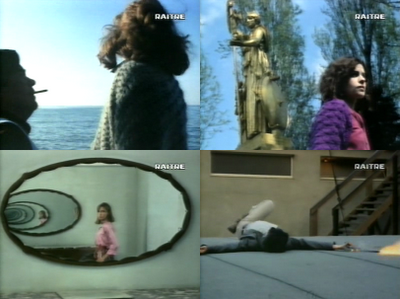

It should be noted that repeated viewings of Spectre help to clarify not its “plot” but its formal organization. The analogy suggested above between Rivette and Coleman is far more relevant, however, to the notion of performance. Much like Coleman’s thirty-eight-minute venture into group improvisation with seven other musicians, Spectre’s surface is dictated by accommodations, combinations, and clashes brought about by contrasting styles of “playing.” The textures run the gamut from the purely cinematic skills of Jean-Pierre Léaud and Juliet Berto to the stage-bound techniques of Françoise Fabian; from the nervousness of Michel Lonsdale to the placidity of Jacques Doniol-Valcroze; from the reticence of Bulle Ogier to the garrulity of Bernadette Lafont.
For Coleman as for Rivette, the thematic material is kept to a minimum and mainly used as an expedient — a launching pad to propel each solo player into a “statement” of his own that elicits responses from the others. Apart from the brief ensemble passages written by Coleman, there is no composer behind Free Jazz, hence no composition; the primary role of Coleman as leader is to assemble players and establish a point of departure for their improvising.
Rivette’s role in Spectre is similar, with the crucial difference that he edits aand rearranges the material afterward, assembling shots as well as players. And the assembly is one that works against the notion of continuity: sustained meaning, the province of an auteur, is deliberately withheld — from the audience as well as the actors. Consequently, it is hardly surprising that the “13” in Spectre never reveals itself as anything more than a chimera. By the time the film is two-thirds over, it is evident that the complot is a pipe dream that never got off the ground, an idea once discussed among thirteen individuals that apparently went no further. Aside from the efforts of certain characters (mainly Lonsdale and Fabian) to keep its real or hypothetical existence hidden, and the attempts or threats of others (Léaud, Berto, Ogier) to “expose” it, the “13” never once assumes a recognizable shape — in the dialogue or on the screen.
Spectre begins by pretending to tell us four separate stories at once. We watch two theater groups rehearsing Prometheus Bound (directed by Lonsdale) and Seven Against Thebes (a collective), and also observe Léaud and Berto — two rather crazed and curious loners, each of whom tricks strangers in cafes out of money. (Léaud impersonates a deaf-mute; Berto usually starts by flirting.) For the first thirty-five shots — ten of them black-and-white stills accompanied by an electronic hum — Rivette cuts between these four autonomous units, establishing no plot connections. The only links set up are occasional formal repetitions: a scene echoed by a subsequent still, two pans in separate shots of Léaud and Berto in their rooms. Even within each unit, many shots are either “too long” or “too short” to be conventionally assimilable as narrative. Rivette often cuts in the middle of a sentence or a movement, and the missing pieces are not always recuperated. Conversely, a shot in which Léaud’s concierge reminds him to leave his key ends irrelevantly with her walking away from the camera and sitting down at a table to write. Like some of the cryptic stills punctuating later portions of the film, such a diversion proposes — without ever substantiating — yet another supplementary fiction.
Then almost miraculously, in the thirty-sixth shot, two of the four “plots” are brought together: Léaud is suddenly handed a slip of paper by a member of the theater collective. On it is typed a seemingly coded message which he sets out to decipher, along with a subsequent message he receives, following clues provided by references to Balzac and “The Hunting of the Snark” (the former gracefully explained by Eric Rohmer in a cameo role). And when Léaud’s deductions eventually lead him to a hippy boutique called “l’Angle du hasard,” the “plot” appreciably thickens: the boutique is run by Ogier, whom we later discover is a friend of both Lonsdale and Michele Moretti, another member of the collective; and all three are members of the alleged “13.”
Meanwhile, Berto, the fourth narrative strand, has been making some unwitting connections of her own. After stealing letters from the flat of Doniol-Valcroze (another one of the “13,” along with his wife, Françoise Fabian) for the purpose of possible blackmail, she dons a wig and arranges a meeting with Fabian: an incongruous match suggesting Mickey Rooney versus Rohmer’s Maud. Then, when she fails to collect money, she turns up at the boutique to try the same ploy with Ogier. This second encounter marks the fusion of all four “plots,” and occurs just before the film’s intermission. It is the only time Berto and Léaud ever cross paths (they are the only important characters who never meet), and the spectator may well feel at this point that he is finally being led out of chaos. But the second half of Spectre, after drawing the four strands together more tightly, proceeds to unravel them again; and the final hour leaves us as much in the dark as we were in the first. Indeed, the delivery of the first message to Léaud is totally gratuitous, an act that is never explained, and most of the other “connections” are brought about by equally expedient contrivances. In a country house occupied at various times by Lafont, Lonsdale, Ogier, and Moretti, Rivette parodies the very notion of “hidden meaning” in a subtler way, by making sure that a single nondescript bust with no acknowledged relation to the “plot” is visible in every room. It even crops up in the locked room possibly inhabited by Igor, Ogier’s missing husband, a room she enters only near the end of the film. Obviously the bust is a joke; but why is it there? To suggest a complot. And according to the tactics of Spectre, suggesting a complot is at once an absurdity and a necessity: it leads us nowhere except forward.
Complot, in short, becomes the motivation behind a series of transparent gestures: spectres of action playing over a void. We watch actors playing at identity and meaning the way that children do, with many of the games leading to dead ends or stalemates, some exhausting themselves before they arrive anywhere, and still others creating solid roles and actions that dance briefly in the theater of the mind before dissolving into something else. Nothing remains fixed, and everything becomes ominous. Relentlessly investigated by Léaud and blindly exploited by Berto, the spectre of the “13” reactivates the paranoia of its would-be members, mainly increasing the distances between them. Other crises intervene (a stranger runs off with the money of an actor in the collective; Ogier threatens to publish the intercepted letters); fear begets fear; both theater groups disperse; Ogier and Moretti are last seen driving off to meet the perpetually missing Igor; and Berto and Léaud are each returned to their isolation. Repeated “empty” shots of Place d’Italie in the final reel — chilling mixtures of Ozu-like emptiness with Langian terror — embody this growing sense of void, which ultimately widens to swallow up everything else in the film.
Much as folie a deux figures centrally in L’Amour Fou and Céline et Julie vont en Bateau, failed folie a deux gradually becomes the very essence of Spectre. The inability to “connect” reveals itself as part and parcel of the incapacity to sustain fictions, a failure registering most poignantly in the relationship of Ogier and Léaud, which begins with mutual attraction and ends in estrangement. Of all the ”two-part inventions” in Spectre, theirs is the richest in shifting tensions, and the growing rift is brilliantly underlined by the staging of their scenes in the boutique — particularly when they’re stationed in adjoining rooms on opposite sides of the screen, each vying in a different way for our attention. This spatial tension reaches its climax in their last scene together, on the street, when Ogier forcibly breaks away and Léaud mimes the invisible barrier between them by pushing at it in agonized desperation, finally wandering in a diagonal trajectory out of the frame while blowing a dissonant wail on his harmonica.
“It didn’t work,” he feebly confesses in the film’s final shot, after repeatedly trying to make his Eiffel Tower trinket swing back and forth exactly thirteen times. Speaking for the audience and the other actors/characters as well as for Rivette and himself, he is testifying to the impossibility of a sustained pattern or meaning. On the deepest level, he is expressing an anguished agnosticism toward all fiction, directing a frightened stare into the face of intractable reality.
An infernal machine programmed to arouse narrative expectations in order to frustrate them, begin stories in order to contradict or cancel them, Spectre cruelly exposes the artifices of cinematic fiction by revealing many of the precise ways that they play on our reflexes. The scenes of violence that figure in the second half — Ogier’s murder of a messenger (played by the film’s producer!) and the brutal beating of Berto by a leather jacket named Marlon (Jean-Francois Stévenin) — are especially disturbing in this respect. They perform the ritualistic role of supplying “action” and “excitement” at junctures whim we probably feel that they’re most sorely needed, yet the reasons for these actions are so enigmatic that they fulfill no other visible function.
Even more than Rivette’s other features, Spectre is built around a series of profound contradictions. Its apparent subject and substance is group effort, yet what it finally conveys is entropy and isolation. The extraordinary freedom of the shooting is counteracted by the aggressive constraint of the montage. One could reproach the film for having either “too little” or “too much” — a paradox reflected in the title, which suggests all colors (spectrum) as well as none (the transparency of a ghost). Without proposing any sort of influence, it is interesting to compare the title of Gravity’s Rainbow, another recent work oscillating between form and formlessness, plotting and chaos, a compulsive desire to control the world and an equally strong desire to leave it alone — a novel, in fact, that proceeds to tie and untie its strands with a similar duplicity of purpose and diffusion of focus.
Before editing Spectre, Rivette spoke in a Le Monde interview of wanting to make it “not a digest of the long version, but another film having its own logic: closer to a puzzle or a crossword game, playing less on affectivity and more on rhymes or oppositions, ruptures or connections, caesuras or censorships.” But it is a game that one submits to rather than plays, for it offers no chances of winning. One can sit before it as though at a tribunal — facing an Inquisition that repeatedly asks “Why?” — or one can watch it like network television, and ignore the contradictions as if they were commercial breaks, viewing it all as pure spectacle. Or — likelier still, alas — one can get caught between these two possibilities, and intermittently become bored. A do-it-yourself kit, Spectre has no singular experience to convey, but a set of raw materials. Like Léeud in the film, we can concoct plenty of formulas out of them. A submerged history of the splinterings and disaffections of Cahiers du Cinéma after 1968? A film as steeped in silences as certain works by Webern? A semi-Sadean exposure of a lot of personal traits that actors generally seek to hide, particularly uncertainty and fear? Or a flight into the unknown seeking no “success” or predetermined destination, only adventure?
Spectre isn’t easy going for anyone, nor was it intended to be. Leaving its audience and its actors each suspended over a void, it offers itself as a dead-end experiment that can be neither emulated nor repeated — although it certainly will be learned from for years to come. Going further in self-annihilating narrative than any director before him, Rivette has burned up all the ground beneath his feet.
2
All in the golden afternoon
Full leisurely we glide;
For both our oars, with little skill,
By little arms are plied,
While little hands make vain pretence
Our wanderings to guide.
— Alice in Wonderland
Without, the frost, the blinding snow,
The storm wind’s moody madness-
Within, the firelight’s ruddy glow
And childhood’s nest of gladness.
The magic words shall hold thee fast:
Thou shalt not heed the raving blast.
— Through the Looking Glass
Céline et Julie vont en Bateau is like a picnic thrown on one of the sections of this charred terrain: a Mad Tea Party with a colorful crazy-quilt tablecloth, loony guests, inspired after-dinner games, and plenty of sweets to eat. Try to catch hold of it and it hurtles ahead like the White Rabbit, and down into a nostalgic burrow where dreams and memory play. More than any other Rivette work, it is about the cinema — what it’s like to watch and what it’s like to create. Unlike La Nuit Américaine, it pursued this subject only by analogy and through evocation.
Ostensibly, the film is about Julie (Dominique Labourier), a librarian with a taste for magic books and Tarot cards, and Céline (Juliet Berto), a cabaret magician whom she first encounters hurrying past her in the opening scene. The initial setting is Montmartre, and the central action comprises the daily visits paid in turn by each girl to a haunted house, from which she emerges looking ravished and stunned, with a piece of candy on her tongue and no memory of what transpired inside — until she eats the candy, which affords an immediate (if scrambled) playback of a Victorian melodrama featuring a little girl named Madlyn, her widower father Olivier (Barbet Schroeder, the movie’s producer), two scheming ladies named Camille (Bulle Ogier) and Sophie (Marie-France Pisier), and Miss Angèle, Madlyn’s nurse, who is played alternately by Céline or Julie.
To encapsulate the film’s point of departure in two overcrowded sentences is to point up its outlandishness, but not the spirited fluidity with which it is made to happen on a screen. As Rivette has indicated, the candy plays an analogous role to the use of Balzac in Spectre — a narrative mechanism designed to permit passageway between separate fictional worlds. But while the separate worlds of Spectre tend to contradict or cancel one another, the double plot of Céline et Julie does precisely the reverse: the two girls in Montmartre clearly generate the story in the house, just as surely as the strange happenings there spawn and enrich the antics of their life outside. And if the skepticism toward fiction in Spectre leads to transparent actions playing over a void, Céline et Julie is like a game of catch played over the same void, with the ball tossed back and forth remaining solid as long as it is kept in motion.
The presence of another, contiguous world lying just beyond the visible one is established in the opening shot. We watch Julie idly smoking on a park bench, and hear an off-screen rasping noise that seems momentarily threatening because it is still undefined. (The next shot reveals that she is drawing a circle on the ground with her foot.) Everything that follows works toward a related impression: Julie’s red magic book, wind in the trees, the voices of unseen children, a cat darting from one bench to another before alighting gracefully on the ground and waiting — all create a mood of pregnant pause and magical suspension in which anything at all might happen…
At which point Céline appears, trailing sunglasses, a scarf, and a wrap behind her. And as Julie takes off in pursuit, we have already embarked on an adventure that goes beyond the boundaries of everyday logic. For the chase is no ordinary event at all — with Céline ever so firmly leading Julie on, and both girls frequently slowing their flight down to a leisurely stroll. The direct sound punctuating their path through a very picturesque Montmartre is occasionally overlaid by incidental piano music. (Rouch spiced with a dash of Minnelli?) Even the precise documentary look of their journey is casually subverted by certain controlled and flamboyant details, like a steady recurrence of the color red — and more important, the beginning of a series of doublings, such as the fact that each girl takes off her shoes at a different stage in the pursuit.
Doubling is indeed an essential part of the film’s structure, figuring between the two plots as well as between the two girls. Shortly after the chase, in the library where Julie works, we find the screen split between the girls in unacknowledged proximity (recalling scenes of Léaud and Ogier in Spectre): in the background, Céline traces her hand in a children’s book with a red Magic Marker, while in the foreground Julie makes red fingerprints with an inking pad. Much later, the traumatic climax of the story in the haunted house shows Madlyn smothered in bed, with the mark of a bloody hand imprinted on her pillow; and the cast of a red hand is one of the many playthings bandied about in Julie’s flat. One might say, in short, that in the course of the film all four women are caught literally red-handed in the act of plotting.
After the library scene, we find Julie back in the park (the children visible this time), where she chants a magic spell, closes her eyes, and the camera cuts — to Julie again in long shot. Then she returns to her flat, encounters Céline on the stairs, and ushers her in to let her take a shower and to bandage her bloody knee. (Both these acts are later “doubled”: Julie takes a shower, and Miss Angèle attends to a wound on Camille’s hand.) Céline launches at once into one of her preposterous tall tales, about tigers and pygmies, and soon after she alludes to a mysterious house, Julie begins to help by supplying some of the details. (“And the women — were they dark or fair?” “Both. Dark and fair.”)
And the next morning, before Julie sets off for the house in question, it is she and not Céline who comes up with the address. (To confound causality further, a snapshot of the house is subsequently discovered in Julie’s trunk.) Similarly, it is Céline who turns up to meet Gilou, Julie’s absurdly romantic boyfriend from Brittany — a rather pathetic figure who apparently needs to be dispensed with in order to clear the way for Olivier, his novelistic counterpart, who boasts a comparably Heathcliffian profile. Offhandedly exchanging roles and lives as well as clothes, each heroine sets off for the house on alternate days, to be admitted into — and then, just as mysteriously, ejected from — the fiction inside. Along with the relationship between the girls, this experience has implied erotic overtones: a sort of narrative rape that can be recollected only in tranquillity with the aid of the candy, usually by both girls together, in achronological Marienbad-like fragments.
As they suck on the sweets in Julie’s flat and react to the fractured replays of this nineteenth-century pastiche, they explicitly become movie spectators — laughing, shrieking, yawning, musing, and dreamily extemporizing on whatever they see. (This “film-within-a-film” even has a title of its own, Phantom Ladies Over Paris, which appears in the main credits.) The screen transforms itself into a mirror, their laughter and amazement fuse with ours, and in the netherworld between film and spectator, dreaming and waking, a collaborative enterprise of creating spectacle as well as watching it begins to take shape. Recalled like shards of a dream, the inner plot requires creative participation in order to become legible, and we assist in this act of completion along with the girls.
At the center of this splendidly murky intrigue are Camille and Sophie, each plotting against the other with poisoned candy or flowers to murder Madlyn, and thereby become eligible to marry Olivier, who made a vow to his late wife not to remarry as long as their daughter lives. Camille, a somewhat faded daisy of the Blanche DuBois species, is glimpsed fluttering down a staircase or appearing in portals like Camilla Horn in Murnau’s Faust, uttering crazed lines like “I’m leaving you the roses because of their thorns” and — when Miss Angèle is removing flowers from Madlyn’s room — “Why this violence?” Sophie, an elegant enigma who hides pieces of candy in a small cupboard, plays games with Madlyn and inexplicably gasps at the sight of the flower she draws.
Each time the events are recalled, the plot is “advanced” or complicated a bit more. But it doesn’t take on its most ghoulish aspects until the girls decide to enter the house together. This time, the pallor of the other principals is a ghostly greasepaint white — recalling the cold cream on Céline’s face in the cabaret dressing room — and when Camille cuts her hand on a broken wine-glass, she bleeds a ghastly blue. The entire intrigue becomes a frozen theatrical tableau, as Céline and Julie in their giddy waking states project their girlish games into and around the gloomy proceedings — blowing their lines as they take turns enacting Miss Angèle, clamorously mocking the behavior of the ghosts (or beautifully parodying Olivier’s narcissism in a “mirror” dumb-show); in general, behaving like some insane derivation of Abbott and Costello having improbably stumbled into a tale by Henry James.
The confrontation is as unsettling and mind-bending as a comic nightmare out of Buñuel, but it ends in exorcism. Céline and Julie escape from the house with Madlyn, shifting the balance between the two plots; and all three, finding themselves back in Julie’s flat, decide to embark on a boat ride. Gliding down a placid river like fugitives from a Renoir film, they come upon the immobile figures of Olivier, Sophie, and Camille, drifting past in another boat. Reassembled more symmetrically, the fictions diverge to go their separate ways; and we cut to Céline on the self-same park bench, opening her eyes to spy Julie hurrying past. The doubles are doubled, the circle is complete; and we’re left with the inquisitive stare and implied Cheshire grin of a mysterious cat.
Once again, Rivette is playing on a contrast of acting styles — chiefly the animated cartoon comportment of Berto (in her richest performance to date) and the theatrical aggressiveness of Labourier. Improvisation still dictates much of the overall texture, but it is conducted within much narrower limits than in Spectre, closer to a “jazz chart” than an open-ended experiment like Coleman’s.
The ambiance is rather like a retrospective of old Cahiers favorites: movie memories reflected as formal diagrams of the appreciations of certain directors by Rivette and many of his colleagues in the 1950s. Thus the elaborate doublings of shots and characters seem partially derived from the discovery of such structures in Hitchcock by Truffaut and Godard (although it is Hitchcock with the causality removed); the retreats into childhood in Hawks’s Monkey Business and the wild dream-creations of Tashlin’s Artists and Models are reproduced in spirit, if not in letter; and other enthusiasms of that period abound, from Mizoguchi and Rossellini to Nicholas Ray and Cocteau.
Indeed, one of the more pleasing aspects of Céline et Julie is the way that it clarifies and helps to redefine much of the cinema that inspired it. A recent Paris revival of Gentlemen Prefer Blondes offers a perfect case in point. Seeing this fifties musical again after Céline et Julie reveals how even the garish cartoon-like simplicity of one of Hawks’s more bloated efforts can accommodate a formal play of exchanges between the leading ladies that is far from simple — the implacable reality of Jane Russell and the sheer mythos of Marilyn coexisting, colliding, connecting, communicating, setting up contrasts, reversals, and fusions with one another beneath and through the established musical comedy conventions. Céline et Julie, by exploring some of the same parameters in a quite different context, illuminates the potential richness of such a film behind its various commercial disguises, throwing up a rich and ravishing jewel box of possibilities.
Consider again the relationship of Berto and Labourier: the “unreal” plastic inventiveness of the former, the assertive psychodrama of the latter. Pointing up the differences, the doublings insure that each fulfills the other’s roles, immediately creating sparks and frictions — as in Labourier’s powerful (if ear-curdling) cabaret number, which quickly gravitates into an assault on the audience (like Russell’s courtroom impersonation of Monroe in Blondes), simultaneously releasing and bearing witness to much of the competitive tension that her performance has previously accumulated.
All Rivette’s features might be regarded as different kinds of horror films; Céline et Julie vont en Bateau is his first horror-comedy. The anxiety and despair of Paris Nous Appartient and La Religieuse, L’ Amour Fou and Spectre seem relatively absent, yet they perpetually hover just beyond the edges of the frames. We still have no privileged base of “reality” to set against the fictions, each of which is as outrageous as the other; and along with Borges, we can’t really say whether it’s a man dreaming he’s a butterfly or a butterfly dreaming he’s a man — although we may feel, in either case, that he and we are just on the verge of waking. It’s a sham, of course — as a spectator complains of Céline’s magic act, before being forcibly evicted from the cabaret — but a sublimely delicious one. As long as the separate fictions interpenetrate, we can stay balanced on Rivette’s precarious tightrope, and don’t have to worry about a net not being there to catch us if we fall. Improvising along with the actors, we look straight ahead and join in the crazy fun, trying to forget that beneath us lies the frightening knowledge of Spectre — that terrible certainty of a long drop that knows no bottom at all.
Originally appeared in Sight and Sound 43, Autumn 1974: p. 190-4. Reprinted in Placing Movies: The Practice of Film Criticism (University of California Press, 1995): p. 142-52.

